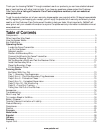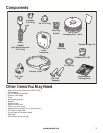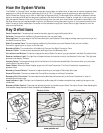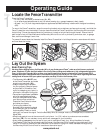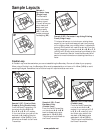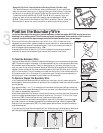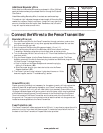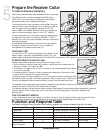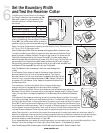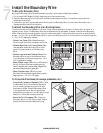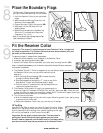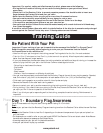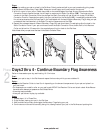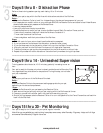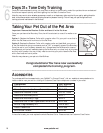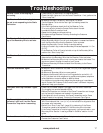
10 www.petsafe.net
Set the Boundary Width
and Test the Receiver Collar
The Boundary Control Switch on the side of
the Fence Transmitter has three settings (6A).
Setting B is used for most properties. The
following table will indicate the setting you
should use.
Amount of Wire Setting
Up to 396 m (1300 ft)
B
396-732 m (1300-2400 ft)
C
Greater than 732 m (2400 ft)
A
Use the Boundary Width Control knob to set the
width of the Warning Zone and Static Correction
Zone (6B). Set the Boundary Width as wide as
possible to give your pet the widest Warning and
6A
5
28
4
10
3
9
1
7
0
6
5
28
4
10
3
9
1
7
0
6
6B
Static Correction Zones without reducing the Pet Area too much. We recommend
a 3.7-6 m (12-20 ft) Boundary width.
Note: The Boundary Width Control knob does not change the Static Correction Level.
To identify the Warning and Static Correction Zones, make sure the Receiver Collar
battery is properly installed, the Static Correction Level is set at 2 or above, and the
Test Light contacts are held to the Contact Points (6C). For best results, select a
section of straight Boundary Wire that is at least 15 m (50 ft) long. Hold the Test Light
tool contacts to the Contact Points. Walk toward the Boundary Wire with Contact
Points pointing up and holding the Receiver Collar at your pet’s neck level (6D) until
the Receiver Collar beeps (6E) and the Test Light Tool fl ashes.
6C
Note: The Receiver Collar is waterproof, which can make the beep hard
to hear.
If the Receiver Collar does not beep at the desired range, adjust the
Boundary Width Control knob to the desired setting. Turning the
Boundary Width Control knob clockwise increases the Boundary Width
while turning it counterclockwise decreases it (6B). Repeat this activity
as needed until the Receiver Collar beeps at the desired distance from
the Boundary Wire.
The numbers on the Boundary Width Control knob indicate signal
strength and are not representative of Boundary Width footage. If
6D
Boundary
Wire
6E
adjusting the Boundary Width Control knob does not give the desired range, adjust the
Boundary Control Switch to another setting to achieve your desired range. If using a Double
Loop, you may need to increase the separation of the Boundary Wire to achieve the desired
range.
The Receiver Collar beeps as a warning tone and ticks when delivering a Static Correction.
After hearing the beep, continue to walk towards the wire. The Receiver Collar should tick and
the Test Light should fl ash, indicating the Static Correction as you enter the Static Correction
Zone (6F). A warning tone and the fl ashing of the Test Light indicate that the Receiver Collar
and the system are working properly. Test in a number of different areas until you are satisfi ed
that the system is functioning properly. Next, walk all around the Pet Area to ensure there are
no areas where the Receiver Collar may activate from signals coupled onto buried wires or
Boundary
Wire
cables. Test the collar in and around the inside of the house as well. As mentioned, cable and wires from cable TV,
electrical or telephone lines may conduct pet fencing signals inside and outside the house that can activate the dog’s
collar accidentally. While rare, if this occurs your Boundary Wire is probably too close to these outside lines and
should be moved or modifi ed as shown in Figure 3A.
If you are satisfi ed that your system is functioning properly, you are ready to start burying the Boundary Wire. If the
Receiver Collar did not beep or the Test Light did not fl ash, see the “Troubleshooting” section.
Note: The Boundary Width is broken down into 20% Warning Zone and 80% Static Correction Zone.
Step
6
6F



